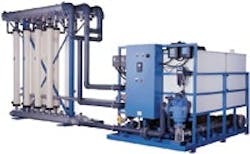Arsenic Showdown
In January 2001, the U.S. Environmental Protection Agency (EPA) reduced the maximum allowable level of arsenic in drinking water from 50 ppb to 10 ppb. The deadline to comply fell in January 2006, causing many smaller communities and non-transient, non-community systems (e.g., schools, churches and nursing homes) to find economical solutions. Among those systems was Fallon, Nev., a city of almost 8,000, which chose to address its arsenic-laden waters using a Pall Aria AP packaged microfiltration (MF) system.
Arsenic is odorless, colorless and tasteless. It can be naturally occurring or a byproduct of wood treatment, mining operations, pharmaceutical manufacturing, pesticide use and other industrial processes. While arsenic is not a problem everywhere, there are some geographic hotspots. In the U.S., these include the Southwest, New England, Michigan, Minnesota, Wisconsin and the Dakotas, where groundwater from wells is ridden with the dangerous element.
According to the National Academy of Science, arsenic in drinking water can harm the central and peripheral nervous system, cause birth defects and reproductive problems, and act as a carcinogen. The new EPA limit of 10 ppb is designed to reduce these dangers significantly.
A number of technologies are available to remove arsenic from drinking water, including: sorption processes (e.g., ion exchange), precipitative processes (e.g., enhanced coagulation/filtration) and membrane processes (e.g., reverse osmosis). Pall Water Processing uses a combination of precipitative and membrane processes with effective arsenic removal.
Fallon’s Story
The process employed in Fallon uses the surface complexing properties of ferric chloride together with a 0.1-micron hollow-fiber MF system—the Pall Aria system, with more than 500 global installations. In Fallon, where arsenic concentration in groundwater was found to exceed 160 ppb, the
MF system reduced levels to less than 2 ppb, well below the World Health Organization guidelines and EPA regulations. Furthermore, the backwash water that is generated during the process (typically less than 5% of the treated water volume) is not considered hazardous waste because the concentrations are well below the threshold legislated by the Resource Conservation and Recovery Act.
Nevertheless, Fallon employs a lamella plate settler and drying bed in order to convert arsenic-heavy backwash waste into solids that are disposed of in a landfill. The supernatant off the lamella settler is brought to the head of the MF plant, significantly increasing overall system recovery.
The Process
Arsenic generally is present in nature as arsenite. The first step of its removal is conversion to arsenate. This is accomplished by employing an oxidizing agent, such as sodium hypochlorite, which is most commonly used. After oxidation, the process continues with enhanced coagulation. Ferric chloride hydrolyzes in water to form ferric hydroxide particles, which have a net positive surface charge at pH values less than 8.0. Arsenate ions are negatively charged and will absorb onto the positively charged ferric hydroxide particles. These particles, or floc, are removed from the water (with the arsenic attached). Note that pretreatment consists solely of chemical addition and rapid mixing—flocculation is not required.
The amount of ferric chloride required to remove arsenic is influenced strongly by pH and ferric hydroxide speciation. Effective removal takes place at pH values below 7.5, where the positive species dominates. Because it is acidic, the addition of ferric chloride alone will depress the pH. At times, however, acid may be required to reduce the coagulant dosing to cost-effective levels. This is all highly dependant on the alkalinity of the water.
MF System Benefits
While proper chemistry is the first key to the arsenic removal process, the second is the MF system. Pall Aria MF systems utilize Microza (a trademark of Asahi Kasei Corp.) hollow-fiber membranes. For municipal applications, these typically are 0.1-micron, highly crystalline, polyvinyldiflouride hollow fibers.
Due to the micron rating, these membranes allow a pin floc to be effective in the removal of arsenic. This eliminates the need for flocculation, keeping the system footprint small and capital costs low. Microza membranes also are highly chemical tolerant, which is necessary because of the harsh cleaning methodology required in such applications. In typical operation, sodium hypo- chlorite and sodium hydroxide are employed during monthly clean-in-place operations. Moreover, when using ferric-based chlorides and/or removing metals from water, acid (usually citric acid) must be employed to clean the membrane surfaces. If not for the aforementioned strength of Microza membranes, integrity failures would be frequent and membrane life would be significantly less than the 10 years expected at Fallon and in similar applications.
Fallon’s MF system has been in operation since August 2004 and, according to Superintendent of Sanitation Kevin Snodgrass, “Everything is working wonderfully.” Furthermore, the 0.5-million- gal-per-day Pall Aria AP-4 packaged system has experienced zero integrity issues, ensuring that the public has not been exposed to harmful levels of arsenic in their drinking water.
Download: Here
